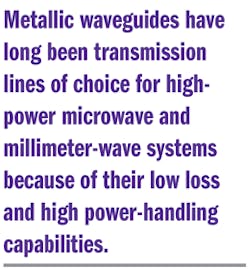Metallic waveguides have long been transmission lines of choice for high-power microwave and millimeter-wave systems because of their low loss and high power-handling capabilities. Tradeoffs in using metallic waveguide include the relatively narrow bandwidths and weight that they add to high-frequency systems.
As an alternative, researchers at NASA’s Jet Propulsion Laboratory (JPL), Pasadena, Calif., developed dielectric waveguides based on long sections of dielectric material. They provide wide bandwidths and low signal loss compared to conventional metallic waveguide. Furthermore, interconnections between sections of the dielectric waveguide use lens coupling to minimize losses at the junctions by a factor of 10 or more compared to metallic-waveguide interconnections.
Conventional metallic waveguides may employ twists or bends to form connections between two sections of waveguide. When dielectric waveguide must be joined to a section of metallic waveguide, the ends of the dielectric waveguide are tapered and then inserted directly into the metallic waveguide, using a long transition to minimize coupling losses between the two media types.
NASA seeks to apply this technology to data-transmission links that cannot tolerate losses, such as in spacecraft, landers, and rovers for interplanetary exploration. It is seeking licensees interested in pursuing this technology commercially; more information can be found at http://technology.nasa.gov/patent/TB2016/NPO-TOPS-46.
See “Lens-Coupled Dielectric Waveguides,” NASA Tech Briefs, August 2016, p. 28.


